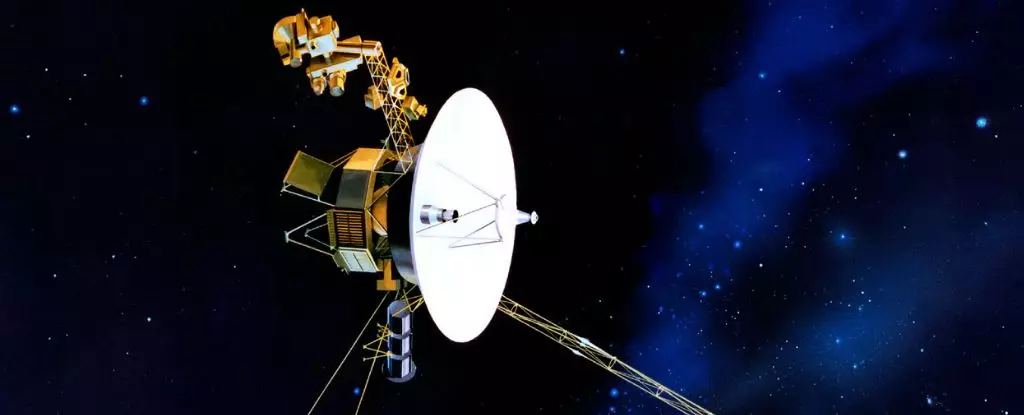In an era where technological innovation seems to progress at lightning speed, the Voyager spacecraft stand as stalwart symbols of human ingenuity and technological longevity. Since their launch in 1977, Voyager 1 and Voyager 2 have traversed the depths of space, propelled by the decay of radioactive isotopes that continue to power their instruments. However, the inexorable passage of time is catching up with these venerable spacecraft. As energy supplies dwindle, NASA has made the difficult decision to deactivate the plasma science instrument aboard Voyager 2, marking a poignant moment in the ongoing saga of humanity’s journey toward the stars.
Voyager 2, now over 47 years old, is still hurtling through the cosmos at a staggering speed of approximately 15 kilometers per second. Currently, it stands more than 20.5 billion kilometers from Earth, a distance that underscores the monumental achievement these missions represent for space exploration. The spacecraft are now entering a critical phase of their mission, known as the Voyager Interstellar Mission, where they continue to send back invaluable data that fosters our comprehension of interstellar space.
Over the years, NASA engineers have carefully managed the remaining energy resources of both Voyager spacecraft to maximize scientific output. Despite the challenges posed by diminishing power levels, Voyager 2 still houses four operational instruments, including essential devices designed to gather data about the mysterious environment beyond our heliosphere. The decision to deactivate the plasma science instrument—a key piece for measuring ionized particles—was driven by its decreased functionality and alignment with plasma flow in interstellar space, alongside the pressing need to conserve energy for other critical scientific operations.
The scientific suite on Voyager 2 is designed to explore various phenomena as it interacts with the vast interstellar medium. The remaining instruments include a magnetometer, charged particle sensors, a cosmic ray detection system, and a plasma wave detector. While the deactivation of the plasma instrument signifies a reduction in the spacecraft’s operational capabilities, it also highlights a broader inevitability: even the most groundbreaking technological endeavors must confront the limits of time and energy.
The Voyager missions were initially conceived to take advantage of a rare planetary alignment that would allow for a grand tour of the outer solar system. This fortuitous alignment, occurring only once every 175 years, allowed Voyager 2 to perform unprecedented flybys of Jupiter, Saturn, Uranus, and Neptune—insights that remain vital to our scientific understanding. Voyager 1 also made notable discoveries during its flybys, contributing significantly to our knowledge of the gas giants and their moons.
The imagery and data collected during these missions redefined our understanding of the outer solar system. Insights gained from the encounters with the gas giants provided new perspectives on planetary atmospheres, magnetic fields, and potential extraterrestrial environments. The remarkable visual data brought the distant outer planets closer to home, energizing public interest in space exploration and expanding the horizons of planetary science.
As Voyager 2 continues its solitary journey through interstellar space, communication with Earth has become a remarkable challenge. Utilizing the Deep Space Network, it takes nearly a day for signals to traverse the cosmic distances between the spacecraft and our planet. The power generated from the multi-hundred-watt radioisotope thermoelectric generators (RTGs) has halved since launch, with an estimated annual loss of approximately 4 watts. A testament to engineering foresight, the RTGs—initially providing a total of 470 watts—were designed to sustain operations long into the future. However, the reality of their declining output foreshadows a future where one by one, vital systems must be turned off, a move made to ensure the longevity of the remaining instruments.
The situation echoes a similar fate experienced by the plasma science instrument on Voyager 1, which ceased functioning in the early 1980s. These transitions serve as poignant markers in the timeline of human exploration, where each deactivated instrument evokes a sense of loss but also highlights the remarkable journey that has unfolded over the decades.
As the Voyager spacecraft continue to push farther into the unknown, they become more than just machines; they embody humanity’s quest for knowledge and understanding about our place in the universe. The decision to shut down the plasma science instrument on Voyager 2 represents a chapter closing in an epic narrative, yet the data received thus far provides insights that will fuel scientific inquiry for generations to come.
Ultimately, the Voyager missions symbolize both the triumphs and tribulations inherent in exploration. They remind us that while time and technology may impose limits, the spirit of discovery knows no boundary. Through the legacy of Voyager, we herald a future of exploration, driven by curiosity and a desire to reach beyond the familiar, embarking on journeys that will stretch the bounds of human understanding for centuries still to come.

